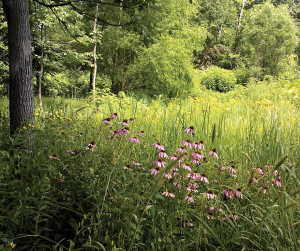Purple Coneflower: Made for the Shade

A common misconception about purple coneflower is that they are sun-worshiping prairie dwellers. Not so. In nature they grow in the woods, open woods that is, or savannas where the trees are widely spaced, limbs are high and only patchy-filtered sunlight reaches the ground floor.
By Scott Woodbury
[This photo was original published in The Gateway Gardener June 2015 issue.]
June is the month for garden tours. Gardens are fresh, unscarred by summer drought and many showy native plants are in full glorious bloom. American aloe, Missouri evening primrose, lance-leaved coreopsis, purple poppy mallow, mountain mint, butterfly milkweed, wild bergamot, and royal catchfly to name a few.
The centerpiece in June is purple coneflower, Echinacea purpurea with its sweet scent of

Purple coneflower in a savannah setting, photo by Scott Woodbury.
rose, purplish ray petals and orange disc flowers full of nectar and pollen. Its nectar is loved by butterflies and bumblebees alike, though the hairy buzzing bees are doing most of the pollinating. Turns out, smooth-slender butterfly legs aren’t as effective as stout hairy bee legs at catching pollen. It also helps if you have a hind leg pollen basket. Yes bumblebees have these to carry their pollen, nectar and spit. Who would have thunk it? Purple coneflowers are also visited by skippers, brush-footed butterflies, bee flies, sweat bees, mason wasps, syrphid flies, fireflies and the predators who love to eat them…hummingbirds and praying mantises. The world is so full of a number of things. Don’t forget to pull up a beanbag chair for a front-row seat at one of the greatest feeding frenzies on earth. And it’s right in your own backyard.
A common misconception about purple coneflower is that they are sun-worshiping prairie dwellers. Not so. In nature they grow in the woods, open woods that is, or savannas where the trees are widely spaced, limbs are high and only patchy-filtered sunlight reaches the ground floor. That’s why I like to call it queen-of-the woods. In older neighborhoods like Webster Groves, gardens with trees like these have what is called high shade. Purple coneflowers thrive in this environment. Gold finches devour purple coneflower seeds in late summer but a few seeds are missed and sprout the following April. Seedlings develop quickly and are easily transplanted in May or June.
Horticulturist Scott Woodbury is the Curator of the Whitmire Wildflower Garden at Shaw Nature Reserve, where he has worked with naitve plant propagation, design and educationf or more than 20 years.
